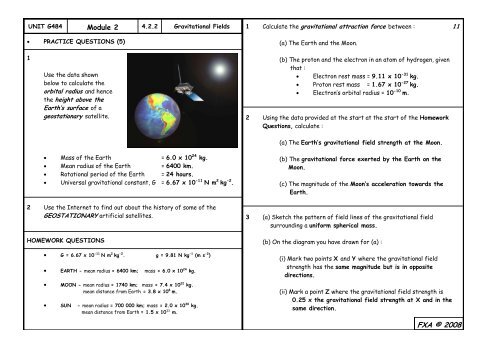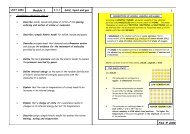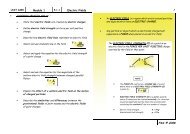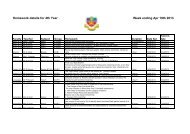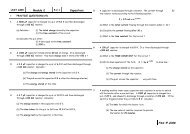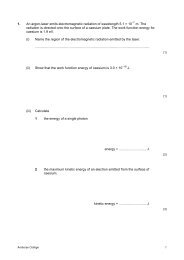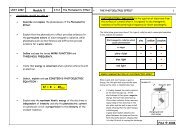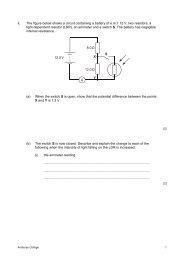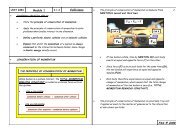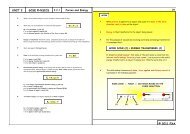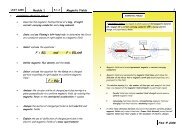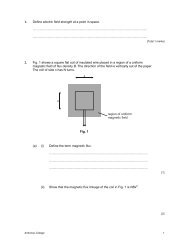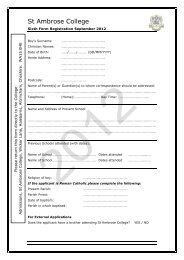Module 2 FXA © 2008 - Animated Science
Module 2 FXA © 2008 - Animated Science
Module 2 FXA © 2008 - Animated Science
- No tags were found...
Create successful ePaper yourself
Turn your PDF publications into a flip-book with our unique Google optimized e-Paper software.
UNIT G484 <strong>Module</strong> 2 4.2.2 Gravitational Fields PRACTICE QUESTIONS (5)1 Calculate the gravitational attraction force between : 11(a) The Earth and the Moon.1Use the data shownbelow to calculate theorbital radius and hencethe height above theEarth’s surface of ageostationary satellite.(b) The proton and the electron in an atom of hydrogen, giventhat : Electron rest mass = 9.11 x 10 -31 kg. Proton rest mass = 1.67 x 10 -27 kg. Electron’s orbital radius = 10 -10 m.2 Using the data provided at the start at the start of the HomeworkQuestions, calculate : Mass of the Earth = 6.0 x 10 24 kg. Mean radius of the Earth = 6400 km. Rotational period of the Earth = 24 hours. Universal gravitational constant, G = 6.67 x 10 -11 N m 2 kg -2 .(a) The Earth’s gravitational field strength at the Moon.(b) The gravitational force exerted by the Earth on theMoon.(c) The magnitude of the Moon’s acceleration towards theEarth.2 Use the Internet to find out about the history of some of theGEOSTATIONARY artificial satellites.HOMEWORK QUESTIONS G = 6.67 x 10 -11 N m 2 kg -2 . g = 9.81 N kg -1 (m s -2 )EARTH - mean radius = 6400 km; mass = 6.0 x 10 24 kg.MOON - mean radius = 1740 km; mass = 7.4 x 10 22 kg.mean distance from Earth = 3.8 x 10 8 m. SUN - mean radius = 700 000 km; mass = 2.0 x 10 30 kg.mean distance from Earth = 1.5 x 10 11 m.3 (a) Sketch the pattern of field lines of the gravitational fieldsurrounding a uniform spherical mass.(b) On the diagram you have drawn for (a) :(i) Mark two points X and Y where the gravitational fieldstrength has the same magnitude but is in oppositedirections.(ii) Mark a point Z where the gravitational field strength is0.25 x the gravitational field strength at X and in thesame direction.<strong>FXA</strong> © <strong>2008</strong>
UNIT G484 <strong>Module</strong> 2 4.2.2 Gravitational Fields4 A planet P of mass (m) orbitsthe Sun of mass (M) in acircular orbit of radius (r),as shown in the diagram.The speed of the planet inits orbit is (v).Pmass = mmass = MSr5 This question is about gravitational fields. You may assume that 12all the mass of the Earth, or the Moon, can be considered as a pointmass at its centre.(a) It is possible to find the mass of a planet by measuring thegravitational field strength at the surface of the planet andknowing its radius.(i) Define gravitational field strength, g.(a) On the diagram, draw anarrow to represent thelinear velocity of P.Label the arrow V.Draw a second arrow representing the direction of the forceacting on P. Label this arrow F.(b) (i) Write down an expression, in terms of r and v, for themagnitude of the centripetal acceleration on P.(ii) Write down an expression, in terms of m, r and v, for themagnitude of the force F acting on P.(iii) Write down an expression, in terms of m, M, r and G, for themagnitude of the gravitational force F exerted by the Sunon the planet.(c) From observations of the motions of the planets around the Sun,KEPLER found that the square of the period of revolution of aplanet around the Sun (T 2 ), was proportional to r 3 .(i) Write down an expression for T in terms of the speed (v) ofthe planet and the radius (r) of its orbit.(ii) Use your answers to (b) (ii), (b) (iii) and (c) (i) to show thatKEPLER’S relation T 2 α r 3 would be expected.(OCR A2 Physics - <strong>Module</strong> 2824 - Specimen paper)(b)(ii) Write down an expression for g at the surface of a planet interms of its mass M and radius R.(iii) Show that the mass of the Earth is 6.0 x 10 24 kg, giventhat the radius of the Earth = 6400 km.(i) Use the data below to show the value of g at the Moon’ssurface is about 1.7 N kg -1 .mass of Earth = 81 x mass of Moon.radius of Earth = 3.7 x radius of Moon.(ii) Explain why a high jumper who can clear a 2m bar on Earthshould be able to clear a 7m bar on the Moon. Assume thatthe high jump on the Moon is inside a ‘space bubble’ whereEarth’s atmospheric conditions exist.(iii) The distance between the centres of the Earth and theMoon is 3.8 x 10 8 m. Assume that the Moon moves in acircular orbit about the centre of the Earth. Estimate theperiod of this orbit to the nearest day.Mass of Earth = 6.0 x 10 24 kg.1 day = 8.6 x 10 4 s.(OCR A2 Physics - <strong>Module</strong> 2824 - January 2003)<strong>FXA</strong> © <strong>2008</strong>
UNIT G484 <strong>Module</strong> 2 4.2.2 Gravitational Fields6 (a) Define gravitational field strength, g.(b) Explain why the acceleration due to gravity and the gravitationalfield strength at the Earth’s surface have the same value.(c) A space probe, with its engines shut down, orbits Mars at aconstant distance of 3500 km above the centre of the planetand in a time of 110 minutes.(i) Calculate the speed of the space probe.(ii) Show that the mass of Mars is about 6 x 10 23 kg.(a) (i) Draw, on the diagram, arrows to represent the force 13acting on each star.(ii) Explain why the stars must be diametrically opposite totravel in the circular orbit.(b) Newton’s law of gravitation applied to the situation shown in thediagram, may be expressed as :F = GM 24R 2State what each of the symbols F, G, M and R represents.(d)(i) Write down an algebraic expression for g at the surfaceof a planet in terms of its mass M and radius R.(ii) The acceleration due to gravity at the surface of Mars is3.7 m s -2 . Calculate the radius of Mars in kilometres.(c)(i) Show that the orbital period T of each star is related toits speed v by :v = 2πR/T(ii) Show that the magnitude of the centripetal force requiredto keep each star moving in its circular path is :7 A binary star is a pair of starswhich move in circular orbitsaround their common centre ofmass. For stars of equal mass,they move in the same circularorbit, shown by the dotted linein the diagram opposite.In this question, consider thestars to be point massessituated at their centres atopposite ends of a diameter ofthe orbit.(OCR A2 Physics - <strong>Module</strong> 2824 - June <strong>2008</strong>)F = 4π 2 MRT 2(iii) Use equations from (b) and (ii) above to show that the massof each star is given by :M = 16π 2 R 3GT 2(d) Binary stars separated by a distance of 1 x 10 11 m have beenobserved with an orbital period of 100 days. Calculate the massof each star. (1 day = 86 400 s).(OCR A2 Physics - <strong>Module</strong> 2824 - June 2004)<strong>FXA</strong> © <strong>2008</strong>


